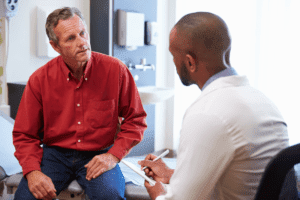Need to Know
- Inform your doctor if you have any allergies, especially to any types of anesthesia, including lidocaine
- Inform your doctor of any and all medications you are currently taking. You may need talk to your doctor beforehand about adjusting or stopping any medications such as blood thinners.
- If you have diabetes, ask your primary care doctor about adjusting your insulin dose
- Inform your technologist if you are pregnant
Nice to Know
- Wear loose, comfortable clothing to your exam
- This procedure is done using local anesthesia so you will not feel pain during the aspiration of fluid
- When the procedure is finished and you feel ready you will be able to go home
- Only a tiny needle is used to perform this procedure and no stitches are needed
- You may feel sore or experience some slight bruising from the procedure. Your doctor might recommend an over-the-counter medication to help relieve any discomfort.
- You should avoid strenuous activity for 24 hours after returning home. You should be able to resume normal activities after that.
- You might want to bring a relative or friend with you to the exam. Or you might arrange to have someone drop you off and pick you up when the procedure is finished.
- You might want to leave valuables, such as jewelry, at home
Frequently Asked Questions
How Does Ultrasound-Guided Aspiration Of A Baker’s Cyst Work?
With the guidance of ultrasound imaging (a painless exam which uses high-frequency sound waves to produce real-time images), your doctor will insert a tiny needle to draw fluid out from behind your knee and shrink or remove the Baker’s cyst. This type of cyst is also known as a popliteal cyst.
What Happens Before, During, And After Ultrasound-Guided Aspiration Of A Baker’s Cyst?
When you arrive for your procedure, the nurse will greet you and let the team know that you have arrived. You will be taken into the exam room and asked to change into a gown. You will be asked to lie on your stomach on the exam table.
The technician and your doctor will then begin the ultrasound portion of the exam. The equipment for the ultrasound resembles a computer with a large screen. The technician will put the transducer – a small, hand-held device that is used to send and receive the ultrasound signals – on the back of your knee to begin the ultrasound. This will create an image of the cyst, which is a fluid-filled sac, on the screen and will enable your doctor to remove the fluid. The ultrasound exam is completely painless.
Once your cyst is located by ultrasound, your doctor will clean the area and give you an anesthetic to numb the area. You will feel a small pinch as the anesthesia is injected. When the area is numbed, your physician will insert a small needle into the skin behind your knee and draw out the synovial fluid. Most patients do not report any pain during the procedure but you may feel slight pressure when the needle is inserted into the cyst.
Once the procedure is complete, your doctor may put a small bandage on the site. You may be instructed to limit strenuous activity for a period of time (usually 24 hours) after the procedure. You will likely be able to return to normal activities after that.
You may feel slight discomfort or bruising after the procedure. In most cases, this can be treated with over-the-counter pain medication. Please talk to your physician about any discomfort you may be experiencing after the procedure.
Your doctor will talk to you briefly after the procedure about any possible follow-up appointments you may need.
How Should I Prepare For Ultrasound-Guided Aspiration Of A Baker’s Cyst?
There are things you can do to make your experience more comfortable, and many of these will depend on your individual preferences. For example, you may want to arrange to have someone drop you off and pick you up. You might like to keep a list of questions or — as you’re doing now — educate yourself about the procedure.
Another important part of your preparation will be guided by your doctor:
- Wear loose, comfortable clothing to the procedure.
- Your doctor may ask you to stop taking aspirin, non-steroidal anti-inflammatory drugs (NSAIDs), or blood thinners (such as Coumadin or warfarin) for a time before the procedure.
- The day before the procedure (or the Friday before, if you’re scheduled for a Monday procedure), a nurse from your doctor’s office will call you. The nurse will give you any additional instructions and will ask if you have any questions.
- When you arrive, make sure the nurse and radiologist know about any allergies you may have, especially allergies to local anesthetics, such as lidocaine. If there’s any chance you may be pregnant, tell your physician.
What Should I Bring To An Ultrasound-Guided Aspiration Of A Baker’s Cyst?
On the day of your procedure you should:
- Wear comfortable, loose-fitting clothes.
- Wear comfortable shoes.
- Avoid bringing jewelry or valuables.
What Are The Benefits And Risks Of Ultrasound-Guided Aspiration Of A Baker’s Cyst?
The benefits of an ultrasound-guided cyst aspiration could include:
- No surgery is required with only a small needle being inserted into the skin.
- Most patients do not report any pain or discomfort during the procedure.
- Recovery time is short, and patients can resume their normal activities.
Risks you should be aware of include:
- As with any procedure, there is a slight risk of infection. The chance of infection requiring antibiotic treatment appears to be less than one in 1,000.
- In some cases, patients report slight discomfort and swelling following the procedure. This can usually be controlled with over-the-counter pain medications. Talk to your doctor if you experience any discomfort following the procedure.
Keep in mind that this information is general. Your radiologist is the best source of information about how these risks and benefits may apply to you.
Locations
Farmington Imaging Center
399 Farmington AvenueFarmington, CT 06032
Monday - Friday | 8:00am - 4:15pm
Weeknight and weekend appointments available for MRI
Weeknight appointments available for Mammography
Hours vary by examMore Information

 This procedure uses image-guided technology to remove a collection of fluid from behind the knee. A Baker’s Cyst, also known as a popliteal cyst, is a benign swelling behind the knee often caused by arthritis or a cartilage tear. If the cyst becomes painful and treatment is required, doctors can use ultrasound imaging to locate the cyst behind the knee. Then, using a very small needle, a physician is able to remove the fluid.
This procedure uses image-guided technology to remove a collection of fluid from behind the knee. A Baker’s Cyst, also known as a popliteal cyst, is a benign swelling behind the knee often caused by arthritis or a cartilage tear. If the cyst becomes painful and treatment is required, doctors can use ultrasound imaging to locate the cyst behind the knee. Then, using a very small needle, a physician is able to remove the fluid.





